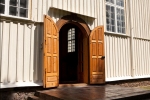April 26, 2011
Strengthening Neighborhoods
Three months ago, I was awoken by the distant sound of a woman screaming for help. Shocked and partially asleep, I opened the window: where were those screams coming from? Fourteen floors above a busy Brooklyn neighborhood, it was impossible to tell. Soon I heard a chorus of dogs barking, and shortly thereafter, sirens. Within minutes, the sirens faded to silence and I found myself looking out the window, chilled, and wondering what had happened and who had been crying out for help.
So often, in cities and rural communities alike, we live more by the maxim of “Don’t talk to strangers” than “Love thy neighbor” – only to have the fragility of our communities exposed in moments like these.
How strong is the social fabric of your neighborhood? How can your Episcopal congregation help strengthen it? I’ve listed a few ideas and resources that I hope you will share with your congregational leadership, but I also hope you will share your own ideas in the section below.
Through a Different Lens
The video above was one of the winners of the 2006 National Neighborhood Day video award contest. As you will see, it is a very simple, two-minute piece reflecting on the sense of isolation that pervades this person’s neighborhood. “I've only met a few of my neighbors, maybe because I don't know how to...Nobody does.”
Watching this as well as a few other of the award-winning videos, I wondered what it would be like if congregational youth or young adults created five-minute videos/photo diaries about their own neighborhoods. What might a congregation learn about their neighborhood's social fabric through this exercise? Click here to see the guidelines set forth by the National Neighborhood Day contest.
Real Needs versus Perceived Needs
This past January, ECF Vital Practices ran a story about an Episcopal congregation that had to discern the real needs, as opposed the assumed needs, of their neighborhood. In Resurrection Leadership, Jeff Fischer of St. Alban's in Waco, TX tells of how his congregation "held weekly 'holy conversations,' inviting leaders of Waco’s helping organizations to talk about the real (rather than perceived) needs among the people of our city." It's an inspiring story about how a congregation became clear about its own identity through deepened engagement and building up of the wider community.
Fact Finding
A number of tools are now available for congregational leaders who want increased data on their neighborhoods. First, the Episcopal Church Center's Office of Research has a tool for studying one's congregation and community. Second, the U.S. Census Bureau has created a new tool for finding detailed information about one's neighborhood. There are video tutorials to help with using the tool, and the information is even searchable by street address.
There are a number of other good practices that I haven't included here on account of time and space, including how one Episcopal congregation is walking the parish bounds and another is building neighbors through a faith garden. But this is because I'd love to hear from you. When have you witnessed the fragility or strength of your neighborhood? How is your congregation working to strengthen those connections?





